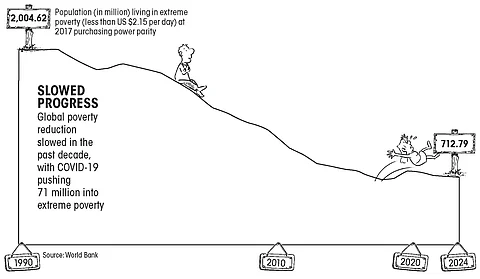

No matter how predatory the natural world is, the interdependence of species does not widen the entitlement gap among them. In contrast, the world of humans is discriminatory. The richest 10 per cent today snap up 52 per cent of all income, while the poorest half get just 8.5 per cent, according to the International Monetary Fund. This is particularly prevalent in a country like India where, according to the World Inequality Lab, the share of the top 10 per cent in national income surged 60 per cent in recent years, compared to the 1990s. At the same time, the share of the bottom 50 per cent remains minimal. As of 2022-23, the top 1 per cent earns 23 times the average income of an Indian. The number of billionaires in India has also been increasing from one in 1991 to 52 by 2011; by 2022, it had more than tripled to 162. Such inequality in income and wealth is staggering and indicates that the gaps are unlikely to close soon.
Poverty reduction has slowed in recent years amid poor economic growth and shocks like the COVID-19 pandemic, high inflation, increased conflict and fragility, says the World Bank. “In many poor settings, poverty rates remain higher than they were five years ago,” says its latest estimate, adding that 2020-30 is set to be a “lost decade”, or a period of economic stagnation.
Poverty rates in poor countries have increased in 2020-23. An additional 133 million people lived in poverty (US $3.65 per person a day) in 2023, UN Development Programme estimates. This number has likely risen by the end of 2024.
More than half of the low-income countries are facing debt distress. These countries spend nearly 7.5 per cent of their budgets in external debt-servicing, as per the World Bank. This will likely peak in 2025, resulting in countries spending less on welfare and development and seeing more people slip below the poverty line.
Climate change may add on to and abet poverty. According to the World Bank, “Nearly one in five people are at risk of experiencing welfare losses due to an extreme weather event from which they will struggle to recover.”
Currently, 8.5 per cent of the world population lives in extreme poverty ($2.15 a person a day). By 2030, this share is likely to be 7.3 per cent, says World Bank. In terms of absolute numbers, there will likely be more poor people in 2030.
Countries will need to raise social spending. There will be progress on a debt deal for poor countries. On the climate front, discussions will focus more on loss and damage compensation, likely helping countries secure their population from climate-related economic losses.
This was first published in the 1-15 January, 2025 Print edition of Down To Earth